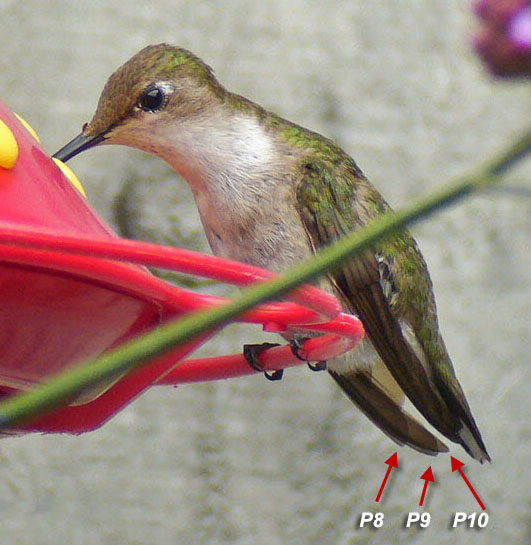
Ruby-throated Hummingbird (Archilochus
colubris)
Bolinas, Marin County, California
12 August 2010
Joseph Morlan
Photo © 12 August 2010 by Joseph Morlan. All rights reserved.
This morning Robbie Fischer and I visited Keith Hansen's studio in Bolinas to see the female Ruby-throated Hummingbird which has been present since Monday, 9 August 2010. We arrived and met Keith at about 10:30 AM. The Ruby-throated Hummingbird flew in to the feeders after about a 10 minute wait. We saw the bird visit the feeders about five times before we left around Noon. Visits were always to the right-most of the three hummingbird feeders and were usually brief, with each visit normally lasting about 10-15 seconds. I attempted to digiscope the bird with the result seen below. The camera was a Panasonic DMC-LZ5 hand-held to a Nikon FieldScope 3 with 30X WA eyepiece.
Description
The following description is based on memory and on the photos.
It was a small hummingbird about the same size as nearby Anna's Hummingbirds but appearing slightly longer tailed than the Anna's and much whiter below. The bill was straight, fairly long, slightly longer than the bills of the Anna's and black in color. There was a small white post-ocular spot and a grayish wash through the ear coverts.
The upperparts were entirely bright glittering green, except on the forehead which appeared grayish. The throat and upper chest appeared entirely white, contrasting with the dark eye and black lore stripe. The rest of the underparts were white, lacking the grayish tones of the Anna's but showing a very faint grayish-buff wash across the breast. In the field this wash was too pale to be noticeable, but it appears on the photos. The undertail coverts were white, lacking the gray spotting evident on the Anna's Hummingbirds.
When the tail was folded, it appeared long and pointed with large white tips visible on the three outer rectrices which were rather pointed at the tip. Photos show that some tail tips were broken supporting the contention that this bird was an adult (AHY). No vocalizations were noted.
The tips to the primaries were studied in detail and I've marked the primary numbers in the photo to the right. Here, the individual primaries are visible on the underside of the distal wing. The outermost (P10) is narrow and pointed. P9 is broader and more truncate and P8 is broader still. This wing-formula is said to be diagnostic for Ruby-throated and eliminates the similar Black-chinned Hummingbird in which the primary tips are more curved and paddle shaped.
As the bird fed, and in one brief period when it flew about and landed in a shrub, I noticed that it never pumped its tail. In my experience Black-chinned Hummingbirds constantly pump their tails up and down while foraging. I understand that this behavioral difference has been confirmed by field testing in Louisiana and may be the easiest way to tell the two Archilochus sp. apart.
Discussion
This is the earliest Fall record of this species for California which has eleven previously accepted records. Six of these are Fall records from Southeast Farallon Island spanning 21 August - 12 September. A previous record of a female at Keith Hansen's feeders in Bolinas on 27-28 August 2007 has been accepted by the CBRC, however an immature male at Keith's feeders last year has apparently not yet been submitted. Keith showed me video of that bird which appeared to me to be correctly identified. Speculation that this year's bird is the same as last year's is unwarranted as this year's bird is a female while last years was an immature male showing a spot of red on the gorget.
Identification of females and immatures can be perilous and this is underscored by five previous mainland California sightings which were not accepted by the California Bird Records Committee.
Additional Photos
Update
The bird was apparently last seen about a half hour after we left and has not been seen since.